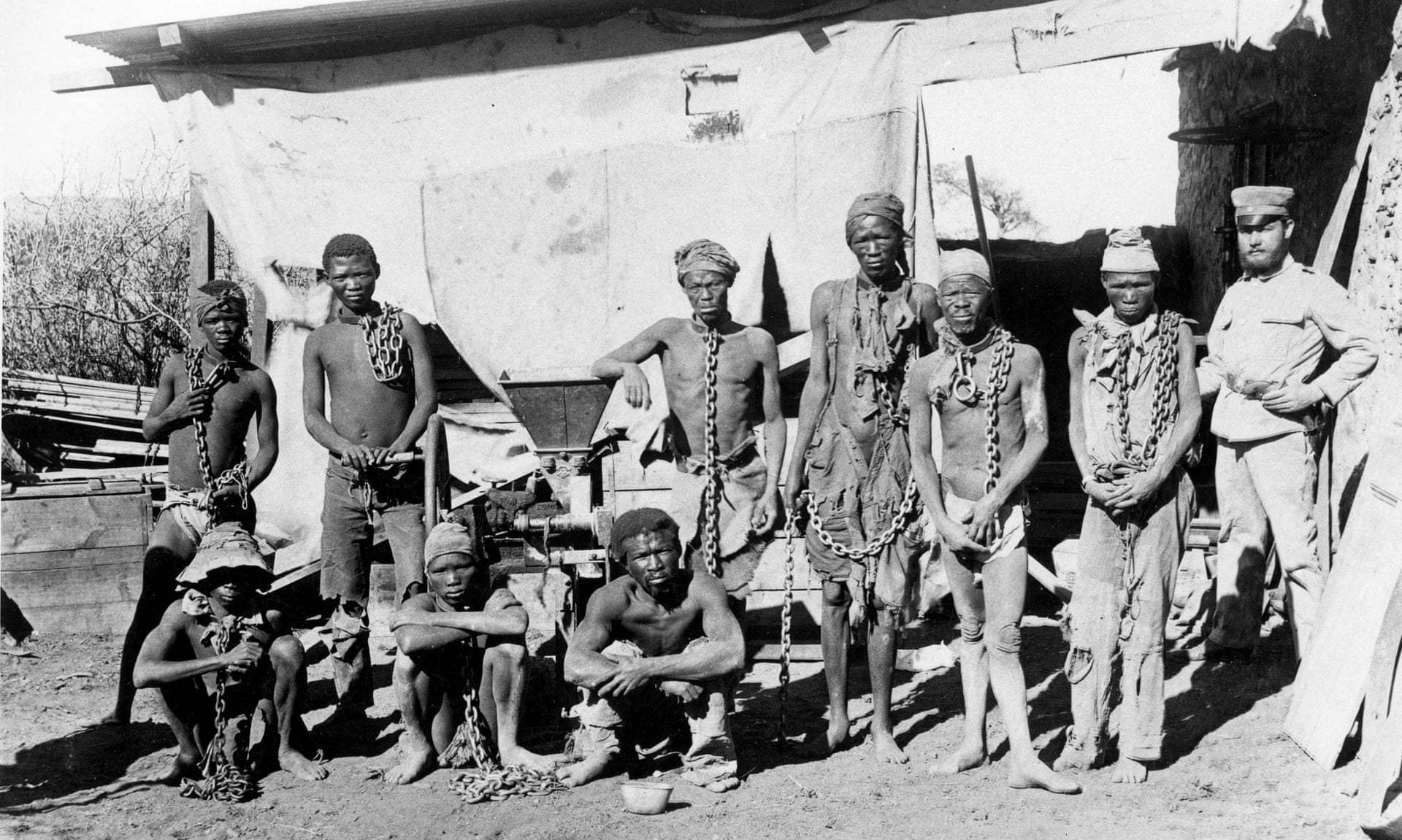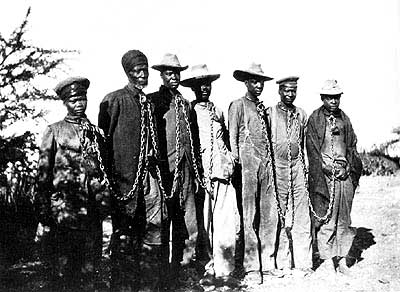
ヘレロ戦争
Herero Wars, 19041-908
German
garrison of Windhoek, besieged by the Herero, 1904
ヘレロ戦争は、ドイツ帝国とドイツ領南西アフリカ(現在のナミビア)のヘレロ族との間で行わ れた一連の植民地戦争である。1904年から1908年にかけて行われた。1904年から1908[1907]年にかけてドイツ領南西アフリカ(現ナミビア)でのヘレロ戦争(Herero Wars)でおこった、ヘレロとナマ虐殺(Völkermord an den Herero und Nama)は、ナマとオヴァヘレロの虐殺(Nama and Ovaherero Genocide)。数万人から10万人の犠牲者が出た。
| The
Herero Wars were a series of colonial wars between the German Empire
and the Herero people of German South West Africa (present-day
Namibia). They took place between 1904 and 1908. |
ヘレロ戦争は、ドイツ帝国とドイツ領南西アフリカ(現在のナミビア)の
ヘレロ族との間で行われた一連の植民地戦争である。1904年から1908年にかけて行われた。 |
| Pre-colonial South-West Africa The Hereros were cattle grazers, occupying most of central and northern South West Africa. Under the leadership of Jonker Afrikaner, who died in 1861, and then later under the leadership of Samuel Maharero, they had achieved supremacy over the Nama and Orlam peoples in a series of conflicts that had in their later stages, seen the extensive use of fire-arms obtained from European traders.[5] |
植民地時代以前の南西アフリカ ヘレロ族は牧畜民で、西南アフリカの中央から北の大部分を占めていた。1861年に死去したヨンカー・アフリカーナの指導の下、そして後にサミュエル・マ ハレロの指導の下、彼らは一連の紛争でナマ族とオルラム族に対する覇権を獲得し、後期にはヨーロッパの商人から得た銃器が広く使用されるようになった [5]。 |
| German colonization In the early 1880s, the German statesman Otto von Bismarck, reversing his previous rejection of colonial acquisitions, decided on a policy of imperial expansion. In 1882 Bismarck gave permission to Adolf Lüderitz to obtain lands which Germany would bring within its "protection", under the conditions that a port was established within the territories taken and that there was "clear title" to the land. Lüderitz bought the title to Angra Pequena (later renamed Lüderitz Bay) from Joseph Fredericks, a chief of the Oorlam people, in exchange for 200 rifles, 2,500 German marks, and some lead toy soldiers, and established a port there. Clarification of Germany's title among the European powers took some time, as the British demurred in response to a German request to clarify the boundaries of their title, however in April 1884 Bismarck instructed the German consul in declare "Lüderitzland" (as Lüderitz's holding in South-West Africa had become known) as under the "protection" of the German Reich. Lüderitz steadily spread Germany's influence throughout the South-West African territory until by 1885 only one tribe within it – the Witboois – had not concluded some kind of arrangement with Germany.[5] Whilst Rhenish missionaries, traders, and other Europeans had been present in the territory since the 1830s, it was only with the advent of Germany's claim to South-West Africa that German settlement of the territory began in earnest. By 1903 there were roughly 4,682 European settlers in the protectorate of whom nearly 3,000 were Germans, most of them in the towns of Lüderitz, Swakopmund, and Windhoek. The advent of large-scale German settlement also brought about changes in the treatment of the native Herero and Nama peoples by Europeans, with native people facing increased legal discrimination and expropriation of land for the use of European settlers.[6] |
ドイツの植民地化 1880 年代初頭、ドイツの政治家オットー・フォン・ビスマルクは、それまで植民地獲得に否定的であったのを一転して、帝国拡大政策をとることを決定した。1882 年、ビスマルクはアドルフ・リュデリッツに、ドイツが「保護」の対象とする土地の取得を許可した。その条件は、取得した領土内に港を設置することと、その 土地に「明確な権利」があることであった。リューデリッツはアングラ・ペケナ(後にリューデリッツ湾と改称)の所有権を、オルラム族の首長ジョセフ・フレ デリックスからライフル200丁、2500マルク、鉛のおもちゃの兵士数体と引き換えに購入し、そこに港を建設したのである。ド イツの領有権明確化の要請に英国が難色を示したため、欧州列強の間でドイツの領有権明確化に時間がかかったが、1884年4月、ビスマルクはドイツ領事に 「リューデリッツランド」(リューデリッツが南西アフリカに保有することで知られた)をドイツ帝国の「保護」下にあると宣言するように指示した。リューデ リッツは順調にドイツの影響力を南西アフリカ全域に広げ、1885年にはドイツと何らかの協定を結んでいなかった部族はウィトボア族だけとなった[5]。 1830年代からドイツの宣教師、商人、その他のヨーロッパ人がこの領土に滞在していたが、ドイツによる南西アフリカへの入植が本格的に始まったのは、ド イツが領有権を主張するようになってからである[5]。1903年までに保護領内にはおよそ4,682人のヨーロッパ人入植者がいたが、そのうち 3,000人近くがドイツ人で、そのほとんどがリューデリッツ、スワコプムント、ウィントフックの町に居住していた。大規模なドイツ人入植者の出現は、先住民であるヘレロ族とナマ族のヨーロッパ人による扱いに変 化をもたらし、先住民はヨーロッパ人入植者の使用のために法的差別と土地の収用に直面するようになった[6]。 |
| Rebellion In 1903, some of the Khoi and Herero tribes rose in revolt and about 60 German settlers were killed. Troops were sent from Germany to re-establish order but only dispersed the rebels, led by Chief Samuel Maharero. In a famous letter to Hendrik Witbooi, the Namaqua chief, Maharero sought to organize his rebellion against the Germans while building alliances with the other tribes, exclaiming Let us die fighting![7] The Herero led a guerrilla campaign, conducting fast hit and run operations then melting back into the terrain they knew well, preventing the Germans from gaining an advantage with their modern artillery and machine-guns. However a conclusive battle was fought on 11 August 1904, at the Battle of Waterberg in the Waterberg Mountains. Chief Maharero believed his six to one advantage over the Germans would allow him to win in a final showdown. The Germans had time to bring forward their artillery and heavy weapons. Both sides took heavy losses, but the Herero were scattered and defeated.[8] In October 1904, General Lothar von Trotha issued orders to kill every male Herero and drive women and children into the desert. As soon as the news of this order reached Germany, it was repealed,[citation needed] but Trotha initially ignored Berlin. When the extermination order was finally suspended at the end of 1904, surviving tribesmen were herded into concentration camps, while others were transferred as slave labor to German businesses; many Herero died of overwork and malnutrition. It took the Germans until 1908 to re-establish authority over the territory. By that time tens of thousands of Africans estimates range from 34,000 to 110,000 had been either killed[9][10]: 296 [11][12][13][14]) or died of thirst while fleeing. 65,000 of 80,000 Hereros and at least 10,000 of 20,000 Nama died as a result of the conflict.[15] At the height of the campaign, some 19,000 German troops were involved.[citation needed] |
反乱 1903年、コイ族とヘレロ族の一部が反乱を起こし、約60人のドイツ人入植者が殺害された。ドイツから治安回復のための軍隊が派遣されましたが、酋長サ ミュエル・マハレロに率いられた反乱軍を分散させるだけでした。マハレロは、ナマクア族の首長ヘンドリック・ウィトボイに宛てた有名な手紙の中で、他の部 族と同盟を結びながらドイツ軍に対する反乱を組織しようとし、「我々は戦って死のう!」と叫んだ[7]。 ヘレロはゲリラ活動を行い、素早くヒット&ラン作戦を行って、よく知った地形に溶け込み、ドイツ軍が最新の大砲と機関銃によって優位に立てるのを防いだ。 しかし、1904年8月11日、ウォーターバーグ山地でのウォーターバーグの戦いで決定的な戦いがあった。マハレロ酋長は、ドイツ軍に対して6対1の優位 に立っていたため、最終決戦で勝つことができると考えていた。ドイツ軍には、大砲や重火器を前に出す時間があった。両軍とも大きな損失を出したが、ヘレロ は散り散りになって敗走した[8]。 1904年10月、ローター・フォン・トロサ将軍は、ヘレロの男性を皆殺しにし、女性や子供を砂漠に追いやるという命令を出した。この命令の知らせがドイ ツに届くとすぐに廃止されたが[citation needed]、トロサは当初ベルリンを無視した。1904年末にようやく絶滅命令が停止されると、生き残った部族は強制収容所に集められ、他の部族はド イツ企業の奴隷労働者として移送され、多くのヘレロが過労と栄養失調で死亡した。 ドイツ軍は1908年までこの地を支配し続けた。その時までに何万人ものアフリカ人が殺されるか[9][10]: 296 [11][12][13][14]) 、逃亡中に喉の渇きで死んでいたと推定されている。8万人のヘレロ族のうち6万5千人、2万人のナマ族のうち少なくとも1万人がこの紛争の結果死亡した [15]。 最盛期には約19,000人のドイツ軍が関与していた[要出典]。 |
| Aftermath In 1915, during World War I, South African forces occupied it in the so-called South West Africa Campaign, and SW Africa officially became a mandate of South Africa in 1920.[16] On 16 August 2004, 100 years after the war, the German government officially apologised for the atrocities.[17] "We Germans accept our historic and moral responsibility and the guilt incurred by Germans at that time," said Heidemarie Wieczorek-Zeul, Germany's development aid minister. In addition, she admitted that the massacres were equivalent to genocide.[18] Not until 2015 did the German government admit that the massacres were equivalent to genocide and again apologised in 2016. The Herero are suing the German government in a class action lawsuit.[19] In 2021, Germany announced that they would repay Namibia €1.1 billion.[20] |
余波 1915年、第一次世界大戦中、南アフリカ軍はいわゆる南西アフリカ作戦でそれを占領し、南アフリカは1920年に正式に南アフリカの委任統治領となった [16]。 戦後100年の2004年8月16日、ドイツ政府は公式に残虐行為を謝罪した[17]。「我々ドイツ人は歴史的、道徳的責任と当時のドイツ人が負った罪を 受け入れる」と、ドイツの開発援助大臣ハイデマリー・ヴィークゾレク=ツォウルは述べた。加えて、彼女は虐殺がジェノサイドに相当することを認めた [18]。 ドイツ政府は2015年になってから虐殺がジェノサイドに相当することを認め、2016年に再び謝罪した。ヘレロ族はドイツ政府を集団訴訟で訴えている [19]。 2021年、ドイツはナミビアに11億ユーロを返済することを発表した[20]。 |
| In literature The Herero Wars and the massacres are both depicted in a chapter of the 1963 novel V. by Thomas Pynchon. The tragic story of the Herero and Namaqua Genocide also appears in Pynchon's 1973 novel Gravity's Rainbow. The heavy toll of the Herero and Namaqua Genocide on individual lives and the fabric of Herero culture is seen in the 2013 historical novel Mama Namibia by Mari Serebrov.[21] The war and the massacres are both significantly featured in The Glamour of Prospecting,[22] a contemporary account by Frederick Cornell of his attempts to prospect for diamonds in the region. In the book, he describes his first-hand accounts of witnessing the concentration camp on Shark Island amongst other aspects of the conflict. |
文学において ヘレロ戦争と虐殺は、1963年のThomas Pynchonの小説『V』の一章で描かれている。また、1973年のピンチョンの小説『重力の虹』にも、ヘレロとナマケアのジェノサイドの悲劇が描かれ ている。 ヘレロとナマケアのジェノサイドが個人の生活とヘレロ文化の構造に与えた大きな犠牲は、マリ・セレブロフによる2013年の歴史小説『ママ・ナミビア』に 描かれている[21]。 戦争と虐殺は、フレデリック・コーネルがこの地域でダイヤモンドを採掘しようとした時の様子を描いた『The Glamour of Prospecting』[22]に大きく取り上げられている。この本の中で彼は、紛争の他の側面とともに、シャーク島の強制収容所を目撃した彼の直接の 記録について述べている[22]。 |
| Bridgman, Jon (1981). The Revolt
of the Hereros. University of California Press. Alnæs, Kirsten (1989). "Living with the past: The Songs of the Herero in Botswana". Africa: Journal of the International African Institute. Cambridge University Press. 59 (3): 267–299. |
|
| https://en.wikipedia.org/wiki/Herero_Wars |
https://www.deepl.com/ja/translator |
+++


/ Herero chained during the 1904 rebellion
Links
リンク
文献
その他の情報



++
Copyleft,
CC, Mitzub'ixi Quq Chi'j, 1996-2099